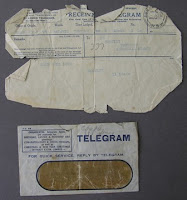- Tight deadlines determined by a project manager or exhibition designer ... that don't take into account the practicalities of carrying out the conservation work itself.
- A complex array of objects, in differing conditions, requiring a variety of conservation treatments.
- Objects that tell fantastic stories, but that are in such a fragile state or deteriorated condition that it is extremely difficult to prepare them for display.
Many of the conservation treatments on objects intended for exhibitions relate to the removal of corrosion and staining as a result of ongoing deterioration so that the object can be more clearly understood when on display, as well as aiming to stabilise the condition of the object so as to halt or slow the rate of that ongoing deterioration.
As well as carrying out the actual conservation treatment, we also need to provide the curators of the exhibition with recommendations for the management of the items whilst on exhibition. These recommendations may include:
- limits on light intensity to minimise deterioration
- time limits for display of the object to minimise deterioration
- need for regular cleaning or re-treatment to manage ongoing corrosion
- methods of support or presentation that will not stress the object
Last year, International Conservation Services undertook conservation treatments on more than 150 objects destined for the new permanent exhibition at the Anzac Memorial in Hyde Park, Sydney, which was opened in November. We also prepared mounts for many of the objects.
These objects included a wide variety of wartime memorabilia and ephemera. We found this project particularly challenging because of the unexpected emotional impact of many of the objects.
In particular, working with documents such as the telegram above provided an immediate window into the emotional impact of the war on families.


The WWI miniature medal illustrated above before and after conservation had been adhered into a storage pocket. We removed it from the pocket, and carried out the following treatments:
- cleaned with ethanol and degreased with white spirit
- metal polished with silver cleaning cloth
- tarnish removed with solution of thiourea in water
- medal coated with clear lacquer to minimise tarnishing whilst on display
- loose threads on ribbon cut, and ribbon stitched back into shape


A combination of rubber, wood, aluminium, copper alloy, iron alloy and canvas, it presented us with a range of challenges. Our treatments comprised:
- brush vacuuming of the entire object
- cleaning of iron alloy components (hinges) with white spirit, fine steel wool, and tannic acid removed with ethanol
- cleaning of copper alloy components with a combination of dilute solutions of triammonium citrate and citric acid, and thiourea, along with mechanical methods (bamboo skewers and scalpel)
- coating of metallic elements with microcrystalline wax to reduce the rate of ongoing corrosion whilst on display
- reattachment of lace-up hooks
David West
International Conservation Services





No comments:
Post a Comment